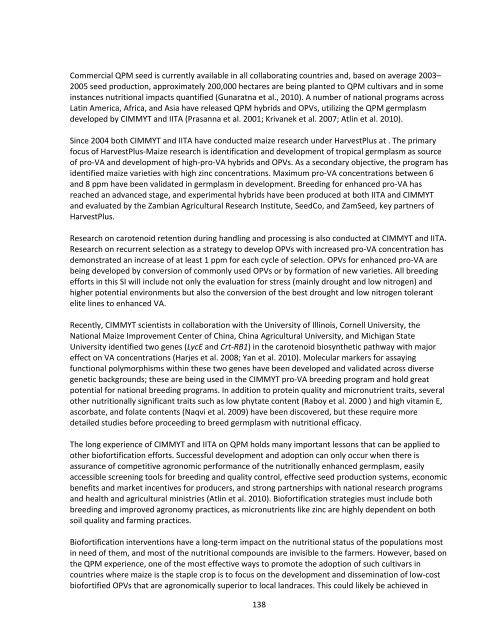Download - Maize
Download - Maize
Download - Maize
Create successful ePaper yourself
Turn your PDF publications into a flip-book with our unique Google optimized e-Paper software.
Commercial QPM seed is currently available in all collaborating countries and, based on average 2003–<br />
2005 seed production, approximately 200,000 hectares are being planted to QPM cultivars and in some<br />
instances nutritional impacts quantified (Gunaratna et al., 2010). A number of national programs across<br />
Latin America, Africa, and Asia have released QPM hybrids and OPVs, utilizing the QPM germplasm<br />
developed by CIMMYT and IITA (Prasanna et al. 2001; Krivanek et al. 2007; Atlin et al. 2010).<br />
Since 2004 both CIMMYT and IITA have conducted maize research under HarvestPlus at . The primary<br />
focus of HarvestPlus‐<strong>Maize</strong> research is identification and development of tropical germplasm as source<br />
of pro‐VA and development of high‐pro‐VA hybrids and OPVs. As a secondary objective, the program has<br />
identified maize varieties with high zinc concentrations. Maximum pro‐VA concentrations between 6<br />
and 8 ppm have been validated in germplasm in development. Breeding for enhanced pro‐VA has<br />
reached an advanced stage, and experimental hybrids have been produced at both IITA and CIMMYT<br />
and evaluated by the Zambian Agricultural Research Institute, SeedCo, and ZamSeed, key partners of<br />
HarvestPlus.<br />
Research on carotenoid retention during handling and processing is also conducted at CIMMYT and IITA.<br />
Research on recurrent selection as a strategy to develop OPVs with increased pro‐VA concentration has<br />
demonstrated an increase of at least 1 ppm for each cycle of selection. OPVs for enhanced pro‐VA are<br />
being developed by conversion of commonly used OPVs or by formation of new varieties. All breeding<br />
efforts in this SI will include not only the evaluation for stress (mainly drought and low nitrogen) and<br />
higher potential environments but also the conversion of the best drought and low nitrogen tolerant<br />
elite lines to enhanced VA.<br />
Recently, CIMMYT scientists in collaboration with the University of Illinois, Cornell University, the<br />
National <strong>Maize</strong> Improvement Center of China, China Agricultural University, and Michigan State<br />
University identified two genes (LycE and Crt‐RB1) in the carotenoid biosynthetic pathway with major<br />
effect on VA concentrations (Harjes et al. 2008; Yan et al. 2010). Molecular markers for assaying<br />
functional polymorphisms within these two genes have been developed and validated across diverse<br />
genetic backgrounds; these are being used in the CIMMYT pro‐VA breeding program and hold great<br />
potential for national breeding programs. In addition to protein quality and micronutrient traits, several<br />
other nutritionally significant traits such as low phytate content (Raboy et al. 2000 ) and high vitamin E,<br />
ascorbate, and folate contents (Naqvi et al. 2009) have been discovered, but these require more<br />
detailed studies before proceeding to breed germplasm with nutritional efficacy.<br />
The long experience of CIMMYT and IITA on QPM holds many important lessons that can be applied to<br />
other biofortification efforts. Successful development and adoption can only occur when there is<br />
assurance of competitive agronomic performance of the nutritionally enhanced germplasm, easily<br />
accessible screening tools for breeding and quality control, effective seed production systems, economic<br />
benefits and market incentives for producers, and strong partnerships with national research programs<br />
and health and agricultural ministries (Atlin et al. 2010). Biofortification strategies must include both<br />
breeding and improved agronomy practices, as micronutrients like zinc are highly dependent on both<br />
soil quality and farming practices.<br />
Biofortification interventions have a long‐term impact on the nutritional status of the populations most<br />
in need of them, and most of the nutritional compounds are invisible to the farmers. However, based on<br />
the QPM experience, one of the most effective ways to promote the adoption of such cultivars in<br />
countries where maize is the staple crop is to focus on the development and dissemination of low‐cost<br />
biofortified OPVs that are agronomically superior to local landraces. This could likely be achieved in<br />
138

















